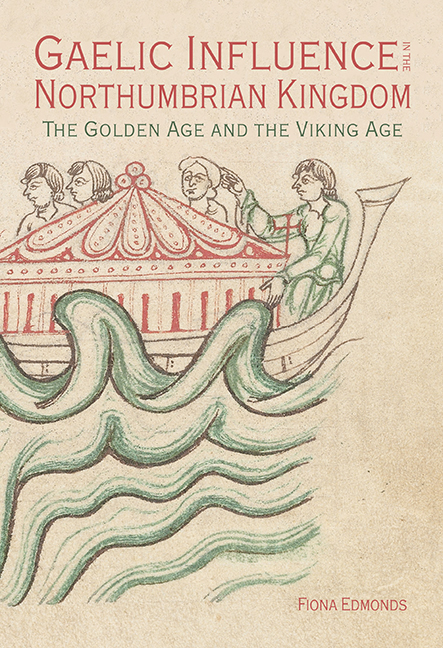Book contents
- Frontmatter
- Contents
- List of Illustrations
- Acknowledgements
- List of Abbreviations
- Preface: An Eventful Voyage
- 1 Concepts and Historiography of the Northumbrian and Gaelic Worlds: Medieval to Modern
- 2 Exiles and Emperors: Gaelic-Northumbrian Political Relations in the Golden Age
- 3 Fragmentation and Opportunity: From the Eighth Century to the Viking Age
- 4 Pathways through the Past: Routes between the Gaelic World and the Northumbrian Kingdom
- 5 A Golden Age of Ecclesiastical Contacts
- 6 Saints and Seaways in the Viking Age
- 7 Medieval Multilingualism: Gaelic Linguistic Influence in the Northumbrian Kingdom
- 8 Movement and Material Culture in the Northumbrian and Gaelic Worlds
- Conclusion: Individuals and Influences
- Bibliography
- Index
- STUDIES IN CELTIC HISTORY
8 - Movement and Material Culture in the Northumbrian and Gaelic Worlds
Published online by Cambridge University Press: 28 February 2020
- Frontmatter
- Contents
- List of Illustrations
- Acknowledgements
- List of Abbreviations
- Preface: An Eventful Voyage
- 1 Concepts and Historiography of the Northumbrian and Gaelic Worlds: Medieval to Modern
- 2 Exiles and Emperors: Gaelic-Northumbrian Political Relations in the Golden Age
- 3 Fragmentation and Opportunity: From the Eighth Century to the Viking Age
- 4 Pathways through the Past: Routes between the Gaelic World and the Northumbrian Kingdom
- 5 A Golden Age of Ecclesiastical Contacts
- 6 Saints and Seaways in the Viking Age
- 7 Medieval Multilingualism: Gaelic Linguistic Influence in the Northumbrian Kingdom
- 8 Movement and Material Culture in the Northumbrian and Gaelic Worlds
- Conclusion: Individuals and Influences
- Bibliography
- Index
- STUDIES IN CELTIC HISTORY
Summary
Material culture has long been seen as a rich source of information about interaction across the Irish Sea. The relationship between peoples, artefacts and structures is, however, fraught with problems, and the association of style and identity has been the subject of much debate. In this chapter I will not seek to identify ‘Gaelic’ or ‘Northumbrian’ material culture, for there was a great deal of variation within the areas inhabited by those peoples. Rather, I trace contacts between specific localities, institutions or social groups.
A comprehensive study of material culture is impossible within the constraints of the book. My main aim in this chapter is to compare and contrast several aspects of material culture with other categories of source material, to test whether they bear out my picture of enduring and varied links between Gaeldom and the Northumbrian kingdom. I will focus on three types of material: ecclesiastical sites, sculpture and portable metalwork. These categories of evidence have the potential to shed light on trends noted elsewhere in the book. Ecclesiastical sites may (or may not) bear out the picture of an upsurge in proprietary churches during the Viking Age, and sculpture has the potential to reveal both high-level ecclesiastical links and the affinities of lay patrons. Personal effects such as dress accoutrements are, by contrast, portable, and may reflect the networks of other social groups (traders, for example). In future, it would be illuminating to augment these case studies with other material, such as the Galloway Hoard, which promises to deepen our understanding of contacts between the Northumbrian kingdom and Gaeldom.
First, I ask how archaeological material can shed light on cultural interaction. The idea of tracing movements of people through distributions of material culture was once a mainstay of the ‘culture-historical school’, which sought to date phases of material culture in northern and western Europe by reference to the Middle East and the Mediterranean. In the mid-twentieth century, radiocarbon dating upset the relative chronologies that had been developed through this ‘diffusionist’ approach. Meanwhile, the archaeologist Gustaf Kossinna associated Germanic peoples with specific artefacts, while downplaying external influences, a discredited approach with nationalist connotations.
- Type
- Chapter
- Information
- Gaelic Influence in the Northumbrian KingdomThe Golden Age and the Viking Age, pp. 185 - 218Publisher: Boydell & BrewerPrint publication year: 2020



